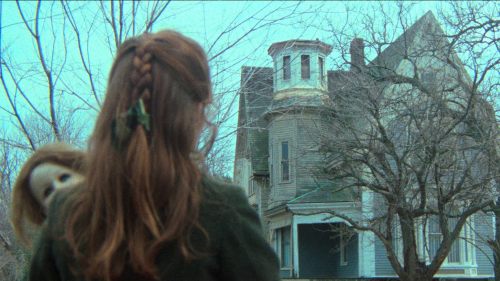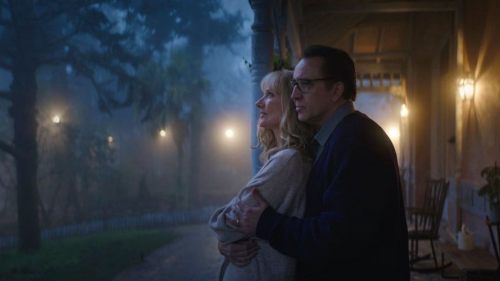THE CURSE (1987): The Meatball Out Of Space
The Color Out of Space is almost here. Get your tickets now!
Before H.P. Lovecraft cinema became a cottage industry, not everyone who adapted the author showed him much respect. The Haunted Palace (1963), the first film based on one of his stories—“The Case of Charles Dexter Ward”—gave Edgar Allan Poe the possessory credit. And The Curse (1987), the second film after 1965’s Die, Monster, Die! to be based on “The Colour Out of Space” (and the first Lovecraft film following Stuart Gordon’s one-two punch of Re-Animator and From Beyond), doesn’t acknowledge the source at all.
Then again, had Lovecraft lived to see The Curse, he might have asked for his name to be left off the credits. It’s a schlocky, overwrought variation on the premise whose principal interest to horror buffs lies in attempting to suss out, as with Poltergeist, how much of the movie was the responsibility of its credited director, and how much was overseen by one of its producers.
The director of record is David Keith, the Firestarter and An Officer and a Gentleman actor who helmed The Curse as the first of a three-picture deal with Trans World Entertainment. When he came aboard, Keith switched the shooting site from California to Tellico Plains, TN, where he owned a farm that in the movie is owned by religious fanatic Nathan Crane (Claude Akins). Nathan lords it over his family, including his wife Frances (Kathleen Jordan Gregory) and his beefy, apparently mentally impaired son Cyrus (Malcolm Danare, who co-starred with Keith in The Lords of Discipline). Top-billed in the film with his face on the poster, however, is Wil Wheaton (misspelled “Will” in the opening credits), then riding high on the success of Star Trek: The Next Generation, as Nathan’s stepson Zack. He even brought his little sister Amy Wheaton on board to make her acting debut as his screen sister Alice.
Scripted by David Chaskin, who previously wrote A Nightmare on Elm Street Part 2 and later stated that The Curse was significantly altered from his screenplay, the movie follows the basic beats of “Colour.” One night, a meteor that resembles a big glowing meatball plummets onto the Crane property, bringing with it a malignance that infects first the crops and then the animals and people, turning them rage-crazed and deformed. This iteration, however, as the title suggests (though the movie was originally called The Well, and then The Farm), posits the blight afflicting the family as a reaction to something—specifically a heavens-sent retribution for adultery committed by Frances. The meteor crashes down just as the unhappy wife is getting it on with farmhand Mike (Steve Davis), a tryst that features the most male body hair in a B-movie sex scene since Ninja III: The Domination. When the affliction takes hold, Nathan reads from Revelations and rants about God punishing them for Frances’ sins.
Yet any meaningful exploration of themes of transgression and penance is eschewed in The Curse in favor of a string of gross-outs. Once the contamination takes hold, everything from lettuce to cows begins oozing slime, someone takes a bite out of a maggot- (OK, mealworm-) filled apple, people develop postulant, leaking boils on their faces and in one case dissolve into glop. Even beyond the meteor’s effects, the movie is suffused with more prosaically icky stuff like messy eating, Zack being pushed into a pile of horse poop, Alice walking barefoot in a filthy chicken coop and a close-up of Cyrus’ hairy butt as Frances applies antiseptic to it.
By the time a cow’s distended stomach explodes and showers onlookers with a gush of maggots and other bugs, it’s not hard to suspect a different hand was at the helm: “Louis” (that would be Lucio) Fulci, credited as associate producer. He was one of several Italian artisans with key positions on the Curse team (also including cinematographer Robert D. Forges/Roberto Forges Davanzati and production designer Frank/Franco Vanorio), and the longer the movie goes on, the more it resembles a product of their home country. A number of the interiors were shot in Rome, which becomes obvious when we visit a doctor’s bedroom that looks like nothing you’d find in small-town Tennessee, and moreso during the last act. It is here that the movie abandons its premise to have the farmhouse itself go berserk and self-destruct, and Keith’s rural-melodrama approach gives way to full-bore Italosplatter Gothic. I haven’t been able to find any conclusive statements supporting the theory that Fulci took the reins of any of this (in a FANGORIA interview, producer Ovidio G. Assonitis claimed Fulci was only responsible for a few effects shots), but what’s on screen makes a fairly strong case.
For his part, Keith only directed one more movie for Trans World, 1988’s The Further Adventures of Tennessee Buck, in which he also starred; he’s remained busy as an actor ever since. The Curse was one of the widest releases from the distributor—which relegated future cult faves Killer Klowns from Outer Space and Sonny Boy to much smaller breaks—and though the theatrical box office was negligible, it did well enough on VHS to spawn three straight-to-tape sequels. Except none of them were actually sequels, but rather unrelated films retitled to tie them in (à la Troll 2). The truly bizarre and ridiculous Curse II: The Bite was originally just The Bite; Curse III: Blood Sacrifice was shot in South Africa with Christopher Lee under the name Panga; and Curse IV: The Ultimate Sacrifice was an Empire Pictures production originally known, and later reissued on disc, as Catacombs. It seems only fitting that this trickery would be applied to follow-ups to a movie that borrowed Lovecraft’s story but didn’t acknowledge his name.



